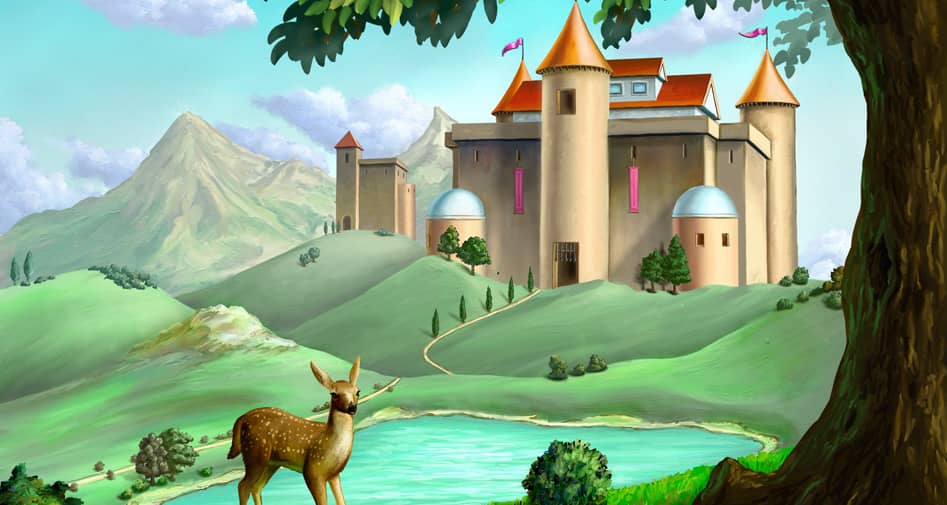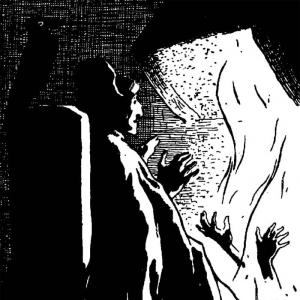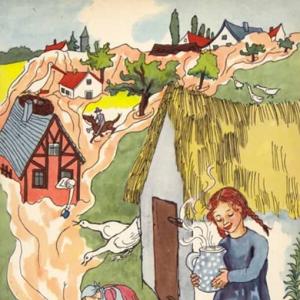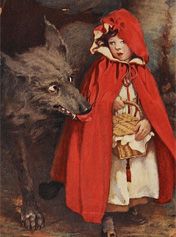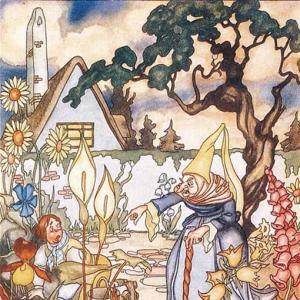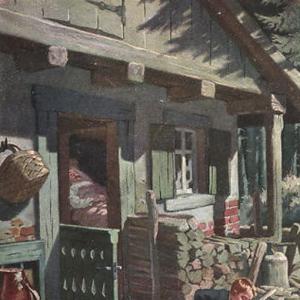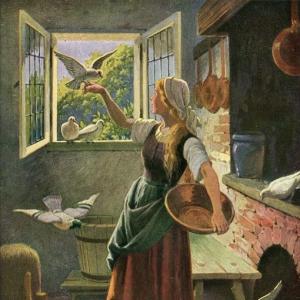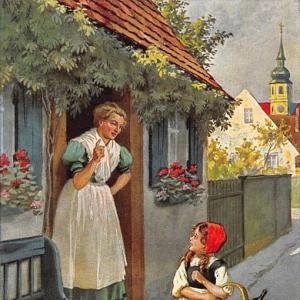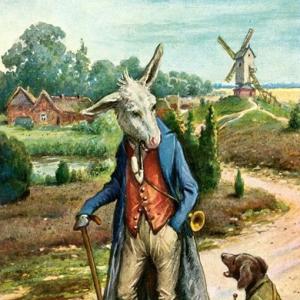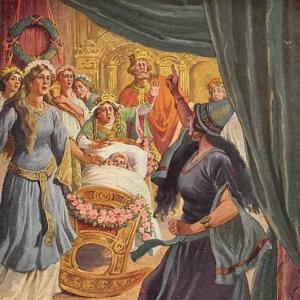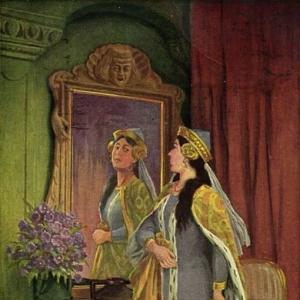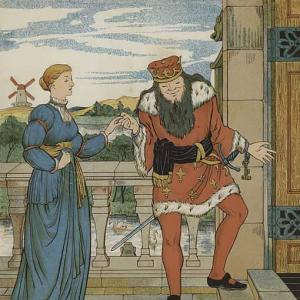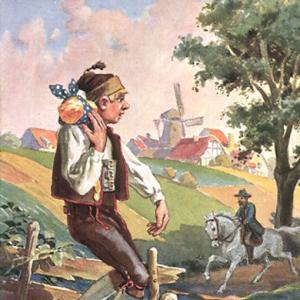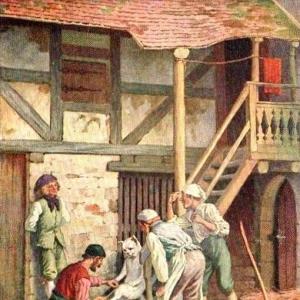Reading time for children: 6 min
On one of the Danish islands, where old Thingstones, the seats of justice of our forefathers, still stand in the cornfields, and huge trees rise in the forests of beech, there lies a little town whose low houses are covered with red tiles. In one of these houses strange things were brewing over the glowing coals on the open hearth. There was a boiling going on in glasses, and a mixing and distilling, while herbs were being cut up and pounded in mortars. An elderly man looked after it all.
„One must only do the right thing,“ he said; „yes, the right– the correct thing. One must find out the truth concerning every created particle, and keep to that.“
In the room with the good housewife sat her two sons. They were still small, but had great thoughts. Their mother, too, had always spoken to them of right and justice, and exhorted them to keep to the truth, which she said was the countenance of the Lord in this world.
The elder of the boys looked roguish and enterprising. He took a delight in reading of the forces of nature, of the sun and the moon. No fairy tale pleased him so much. Oh, how beautiful it must be, he thought, to go on voyages of discovery, or to find out how to imitate the wings of birds and then to be able to fly! Yes, to find that out was the right thing. Father was right, and mother was right– truth holds the world together.
The younger brother was quieter, and buried himself entirely in his books. When he read about Jacob dressing himself in sheep-skins to personify Esau, and so to usurp his brother’s birthright, he would clench his little fist in anger against the deceiver. When he read of tyrants and of the injustice and wickedness of the world, tears would come into his eyes, and he was quite filled with the thought of the justice and truth which must and would triumph.
One evening he was lying in bed, but the curtains were not yet drawn close, and the light streamed in upon him. He had taken his book into bed with him, for he wanted to finish reading the story of Solon. His thoughts lifted and carried him away a wonderful distance. It seemed to him as if the bed had become a ship flying along under full sail. Was he dreaming, or what was happening? It glided over the rolling waves and across the ocean of time, and to him came the voice of Solon; spoken in a strange tongue, yet intelligible to him, he heard the Danish motto: „By law the land is ruled.“
The genius of the human race stood in the humble room, bent down over the bed and imprinted a kiss on the boy’s forehead: „Be thou strong in fame and strong in the battle of life! With truth in thy heart fly toward the land of truth!“
The elder brother was not yet in bed. He was standing at the window looking out at the mist which rose from the meadows. They were not elves dancing out there, as their old nurse had told him. He knew better– they were vapours which were warmer than the air, and that is why they rose. A shooting star lit up the sky, and the boy’s thoughts passed in a second from the vapours of the earth up to the shining meteor. The stars gleamed in the heavens, and it seemed as if long golden threads hung down from them to the earth.
„Fly with me,“ sang a voice, which the boy heard in his heart. And the mighty genius of mankind, swifter than a bird and than an arrow– swifter than anything of earthly origin– carried him out into space, where the heavenly bodies are bound together by the rays that pass from star to star. Our earth revolved in the thin air, and the cities upon it seemed to lie close to each other. Through the spheres echoed the words:
„What is near, what is far, when thou art lifted by the mighty genius of mind?“
And again the boy stood by the window, gazing out, whilst his younger brother lay in bed. Their mother called them by their names: „Anders Sandoe“ and „Hans Christian.“
Denmark and the whole world knows them– the two brothers Oersted.
 Learn languages. Double-tap on a word.Learn languages in context with Childstories.org and Deepl.com.
Learn languages. Double-tap on a word.Learn languages in context with Childstories.org and Deepl.com.Backgrounds
Interpretations
Adaptions
Summary
Linguistics
„Two Brothers“ is a fairy tale by the famous Danish author Hans Christian Andersen, known for his numerous contributions to children’s literature, including stories such as „The Little Mermaid,“ „The Ugly Duckling,“ and „The Snow Queen.“ Born in 1805, Andersen’s stories have been translated into more than 125 languages and have become an integral part of Western children’s literature.
„Two Brothers“ stands out among Andersen’s other stories, as it is based on the lives of two real Danish brothers, Hans Christian Oersted (1777-1851) and Anders Sandoe Oersted (1778-1863). The brothers were influential figures in the fields of science and law during their time and were deeply inspired by their upbringing, as portrayed in the tale.
Hans Christian Oersted was a prominent physicist and chemist, best known for his discovery of electromagnetism in 1820, which played a significant role in the development of modern physics. He also contributed to the fields of optics, crystallography, and the establishment of the first Danish technological institute, the Technical University of Denmark.
Anders Sandoe Oersted, on the other hand, was a distinguished jurist, politician, and botanist. He served as Denmark’s Attorney General and later as Chief Justice of the Supreme Court. He also became a professor of botany and made significant contributions to the study of plants in Denmark and abroad, particularly in Central America.
„Two Brothers“ thus serves as a tribute to the Oersted brothers and their remarkable accomplishments, drawing attention to the themes of truth, knowledge, human potential, and family values that shaped their lives and work.
„Two Brothers“ by Hans Christian Andersen offers several interpretations, focusing on themes of truth, knowledge, human potential, and family values.
The Pursuit of Truth and Knowledge: The story emphasizes the importance of seeking truth and understanding in the natural world, as well as in literature and human interactions. The elder brother’s fascination with the forces of nature and the younger brother’s dedication to learning from books both illustrate the value of curiosity and the drive to comprehend the world around them.
The Power of Human Potential: The brothers‘ visions or dreams, where they are transported by the mighty genius of mankind, demonstrate the limitless potential of the human mind. Their subsequent achievements in science and literature, as well as their international renown, further reinforce the idea that individuals are capable of great accomplishments when they are driven by curiosity, determination, and a passion for discovery.
Family Values and Upbringing: The mother’s teachings on truth, justice, and righteousness play a significant role in shaping the brothers‘ characters and future success. By instilling strong values and encouraging the pursuit of knowledge, she lays the foundation for her sons‘ accomplishments. This theme highlights the importance of nurturing and guiding children to become compassionate, morally upright, and intellectually curious individuals.
Unity in Diversity: Although the two brothers have different interests and pursuits, they share a common passion for truth and knowledge, and their individual achievements contribute to the overall progress of humanity. This theme suggests that people, despite their differences, can come together and work towards the greater good.
The Triumph of Truth and Justice: Throughout the story, both brothers firmly believe in the ultimate victory of truth and justice over deceit and injustice. Their lives become testaments to this belief, as their contributions to science and literature serve to illuminate and inspire generations to come. This theme underscores the importance of maintaining a strong moral compass and using one’s talents to promote good in the world.
Overall, „Two Brothers“ by Hans Christian Andersen serves as an inspiring tale of intellectual curiosity, personal growth, and the power of human potential, while emphasizing the importance of family values and the pursuit of truth and justice.
„Two Brothers“ by Hans Christian Andersen has been adapted in various forms and media, including:
Film adaptations: The fairy tale has been adapted into several films, including „Brothers“ (1977), a Soviet animated film, and „The Two Brothers“ (1994), a Japanese animated film.
Stage adaptations: The story has been adapted into stage productions, including a ballet version by the Royal Danish Ballet, choreographed by Flemming Flindt, and a musical adaptation by the composer Frank Loesser.
Literature adaptations: The story has been retold in various forms of literature, including picture books, chapter books, and graphic novels. One notable retelling is „The Golden Key“ by George MacDonald, which features a similar plot and themes.
Audio adaptations: The story has been adapted into audio format, including audiobooks and podcasts. One notable adaptation is „Fairy Tales of Hans Christian Andersen“ by Jimcin Recordings, which features a collection of Andersen’s fairy tales, including „Two Brothers.“
Visual adaptations: The story has been adapted into visual art, including illustrations and paintings. One notable illustration is by the artist Edmund Dulac, which features an ethereal depiction of the two brothers.
Overall, „Two Brothers“ by Hans Christian Andersen has inspired various adaptations in different media, showcasing the enduring popularity and relevance of the fairy tale.
„Two Brothers“ by Hans Christian Andersen is a tale set in a small Danish town where an elderly man is dedicated to discovering the truth about every particle of creation. His two young sons, still small but full of ambition, are nurtured by their mother, who teaches them the values of truth, justice, and righteousness.
The elder brother, adventurous and inquisitive, is fascinated by nature and dreams of exploring the world or discovering the secret to flight. The younger brother, more introspective, immerses himself in books, often becoming emotional over stories of deceit and injustice. Both boys believe that truth and justice will ultimately prevail.
One evening, the younger brother lies in bed, absorbed in the story of Solon. As he drifts between waking and dreaming, he imagines his bed becoming a ship sailing across the ocean of time. The spirit of Solon speaks to him, imparting the Danish motto, „By law, the land is ruled.“ The genius of the human race appears, blessing the boy with strength and urging him to seek the land of truth.
Meanwhile, the elder brother gazes out the window at the rising mist, contemplating the wonders of nature. He is suddenly swept into space by the mighty genius of mankind, where he experiences the interconnectedness of the universe. The celestial journey leaves him awestruck, realizing the vastness of knowledge and the power of human potential.
Their mother calls to them, revealing their names as „Anders Sandoe“ and „Hans Christian.“ The tale is about the two famous Danish brothers, Anders and Hans Christian Oersted, who went on to become renowned figures in the fields of science and literature, respectively. Through their pursuit of truth and knowledge, they became symbols of human achievement, demonstrating the power of the human spirit and the importance of staying true to one’s values.
The excerpt from Hans Christian Andersen’s fairy tale „Two Brothers“ is rich in linguistic and thematic elements that reveal both the style and underlying message of the narrative.
Setting and Tone: The story begins with a detailed description of a Danish landscape reminiscent of folklore, invoking imagery of ancient justice („Thingstones“) and nature („forests of beech,“ „cornfields“). There’s a sense of nostalgia and mystique associated with the setting, typical of Andersen’s fairy tales, creating an atmospheric backdrop that blurs reality and fantasy.
Characterization: The brothers are depicted with contrasting personalities and interests. The elder brother is curious and adventurous, fascinated by natural sciences and exploration. The younger brother is introspective and concerned with moral integrity. Despite their differences, both brothers are united by their parents‘ teachings of truth and justice, reflected in their aspirations. This duality emphasizes the theme of balance between intellectual curiosity and ethical grounding.
Imagery and Symbolism: Andersen uses vivid imagery and symbols. The elder brother’s visions of „voyages of discovery“ and „wings of birds“ underscore his imaginative and scientific aspirations. The younger brother’s reaction to stories of deception illustrates his strong sense of justice, while his dream of sailing with Solon symbolizes a quest for wisdom.
Themes
Truth and Justice: The story repeatedly emphasizes the significance of truth, described as „the countenance of the Lord in this world,“ and justice, portrayed as a triumph over wickedness.
Intellectual Pursuit: The narrative highlights the importance of seeking knowledge. This is reflected in the elder brother’s quest for understanding natural phenomena and the younger brother’s reflections on justice.
Narrative Style: The language is lyrical and philosophical, often shifting between the literal and the metaphorical. Andersen crafts sentences that are both descriptive and contemplative, inviting readers to ponder deeper meanings. Dialogue is minimal, but the inner thoughts of the characters are richly detailed, providing insight into their motivations and forming a moral and intellectual connection between the reader and the characters.
Motifs
Science vs. Morality: The elder brother’s scientific curiosity is juxtaposed with the younger brother’s ethical concerns, mirroring the story of the Oersted brothers, who are notable figures in both science and moral philosophy.
Use of Direct Speech and Voices: The voices the brothers hear, such as Solon’s and the cosmic call from the stars, are symbolic, representing their internal drives and external influences. The dialogues they have with these imagined or dreamt entities guide them toward their respective paths.
Conclusion: The revelation of the brothers‘ identities as Anders Sandoe and Hans Christian Oersted connects the narrative to real historical figures, grounding the fantastical elements in reality and emphasizing the impact of their respective contributions to science and philosophy.
Overall, Andersen’s „Two Brothers“ is a layered narrative that uses linguistic devices to explore themes of truth, justice, and the pursuit of knowledge. Through contrasting characters, vivid imagery, and symbolic elements, the story reflects the dual pathways to understanding—scientific inquiry and moral philosophy.
Information for scientific analysis
Fairy tale statistics | Value |
|---|---|
| Translations | DE, EN, DA, ES, NL |
| Readability Index by Björnsson | 31.9 |
| Flesch-Reading-Ease Index | 79.8 |
| Flesch–Kincaid Grade-Level | 6.7 |
| Gunning Fog Index | 9.2 |
| Coleman–Liau Index | 8.6 |
| SMOG Index | 8.5 |
| Automated Readability Index | 7.3 |
| Character Count | 3.948 |
| Letter Count | 3.055 |
| Sentence Count | 40 |
| Word Count | 737 |
| Average Words per Sentence | 18,43 |
| Words with more than 6 letters | 99 |
| Percentage of long words | 13.4% |
| Number of Syllables | 944 |
| Average Syllables per Word | 1,28 |
| Words with three Syllables | 34 |
| Percentage Words with three Syllables | 4.6% |
